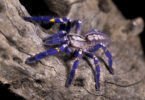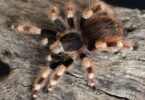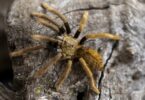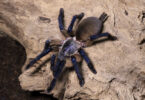Chromatopelma cyaneopubescens, are beautiful and captivating tarantula species that require special attention to care for. They are commonly known as the Green Bottle Blue Tarantula due to their bright blue-green carapace and metallic blue legs.
Looking after these spiders in captivity can be a challenge but this guide will help provide all the information you need for happy, healthy spiders in your collection. Through this blog post we’ll explore what it takes to keep Chromatopelma cyaneopubescens thriving, from enclosure requirements to shipping concerns and customer service tips.
Get ready-this is an adventure worth diving into!
Overview of Chromatopelma cyaneopubescens
Are you a curious tarantula keeper looking to add a small and unique species to your collection? The vibrant greenbottle blue tarantula, or Chromatopelma cyaneopubescens, is an ideal choice due to its low-maintenance enclosure requirements and docile temperament. In this article, we will cover everything from origin and physical characteristics of the species, to breeding tips and recommended care sheets for starting out. Read on to learn more about these mesmerizing creatures!
Habitat and Origin
Chromatopelma cyaneopubescens, commonly referred to as the Green Bottle Blue Tarantula or GBB, is a terrestrial species of spider native to the Paraguaná Peninsula in northern Venezuela.
They are known for their body coloration, and make a great addition to any tarantula collection. This New World species inhabits semi-arid desert environments with minimal rain fall and temperatures that can range from mild during nights up to over 32 °C (90°F) during some days.
To survive this daunting climate they construct heavily webbed burrows under local foliage such as bushes or tree roots where they remain during periods of extreme weather conditions or drought before venturing out at night when safer conditions exist.
Physical Characteristics
Greenbottle blue tarantula, is a species of spiders native to Venezuela that stands apart from other tarantulas thanks to its vibrant orange abdomen, metallic blue legs covered with orange hairs, and blue carapace.
Growing at a medium rate, these spiders will reach a leg span of 6 inches when fully grown. They also have mild venom and can use urticating hairs for defense.
Unlike many temperate climate spiders, Chromatopelma cyaneopubescens can be kept at lower temperatures making it possible for hobbyists to easily keep them in captivity. However, they tend to be more aggressive than most tarantulas which makes handling with care an important factor when owning such an amazing spider!
Enclosure Requirements
Chromatopelma cyaneopubescens requires different sizes of enclosures at each life stage. Spiderlings should be kept in small, shallow containers with substrate that allow for burrowing and items for webbing like cork bark and yarn.
Juveniles can be moved to an enclosure with additional vertical and horizontal space that also contains anchor points from which they can make webs – the sides of this type of container usually need to reach around 7-8 inches (18-20 cm) high.
For adults, it is important to offer plenty of room as these tarantulas are big – preference will vary on substrate level but a good size is 11×11 inches (30x30cm).
The species favors dry environments where temperatures range between 75°F - 80°F (24°C - 26 °C) as natively found in its home climate, Venezuela’s dry and grassy climate. To help retain moisture levels most effectively throughout spider’s life cycle use coconut fiber as substrate; also fill the water dish with fresh drinking water every few days.
Keeping the enclosure humidity around 60% ensuring your Chromatopelma cyaneopubescens remains comfortable all times!
Temperament and Venom
When it comes to temperament, the Green Bottle Blue Tarantula is known for being skittish and defensive. It has a weak venom not considered deadly to humans. The tarantula will also use urticating hairs as a defense mechanism when feeling threatened — this may be especially pronounced when the spider feels threatened.
Individuals generally become more aggressive before their molt and refuse food items regularly, thus making them much harder to handle than usual until after they have shed their exoskeleton.
As with any species of tarantula, caution should always be taken whenever handling or manipulating them even if they do not seem particularly stressed or excitable at the time; sudden movements could cause those hairs which are naturally only lightly attached as part of their protective mechanisms to come off quite easily in response.
Breeding of Chromatopelma cyaneopubescens
Chromatopelma Cyaneopubescens, or the Greenbottle Blue (GBB) tarantula, is a species relatively hard to breed in captivity. To maximize success it’s important for potential keepers to consider factors like enclosure requirements, temperature, and humidity before setting up their breeding project.
Temperature should be around 82°F/28°C.
Throughout mating process there is typically minimal interaction between males and females— this might take even a few hours.
If mating has been successful, 8–10 weeks later mature females can produce an egg sac containing anywhere from 100–200 eggs which she will guard until spiderlings emerge roughly three weeks after hatching.
A common practice in breeding involves having many females, increasing the chances of successful attempts with at least some of them.
Conclusion
The Chromatopelma cyaneopubescens, otherwise known as the Green Bottle Blue or GBB Tarantula, is considered a manageable tarantula species with amazing colors and patternation.
With patience in caring for this species, it can live up to 15 years as an adult female - making them a fantastic long term pet. They require special enclosures that provide plenty of webbing anchor points.
Their mild venom makes them suitable for beginners who can follow basic instruction. Furthermore, their growing popularity among breeders has made this species widely available for those looking to adopt one into their homes!
FAQs
1. What is Chromatopelma cyaneopubescens?
Chromatopelma cyaneopubescens, also known as the Greenbottle Blue tarantula, is a species of spider found in Venezuela.
2. How do I care for this species of tarantula?
Greenbottle Blue Tarantulas should be kept at temperatures between 25 and 32 degrees Celsius with humidity levels around 60%. They should be fed weekly with crickets or other suitable food sources such as cockroaches, mealworms, superworms etc..
3. Is Chromatopelma cyaneopubescens a good choice for a first pet?
Chromatopelma cyaneopubescens is a great choice for a first tarantula due to its incredible coloration, mild venom, ease of care, and insatiable appetite.






